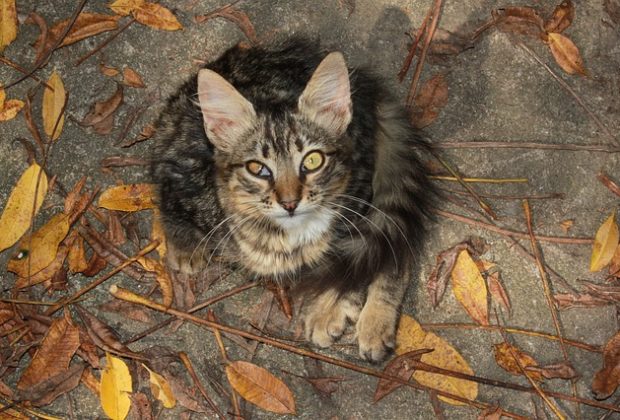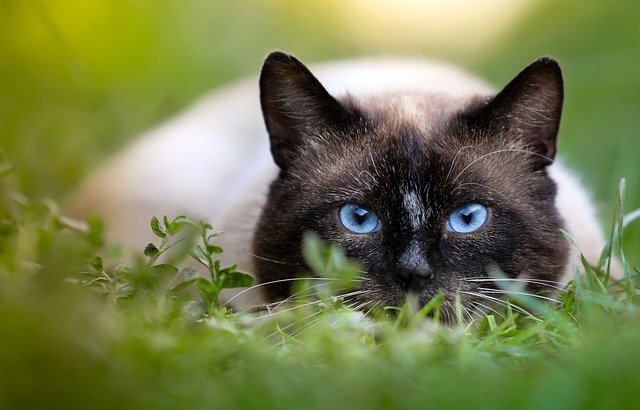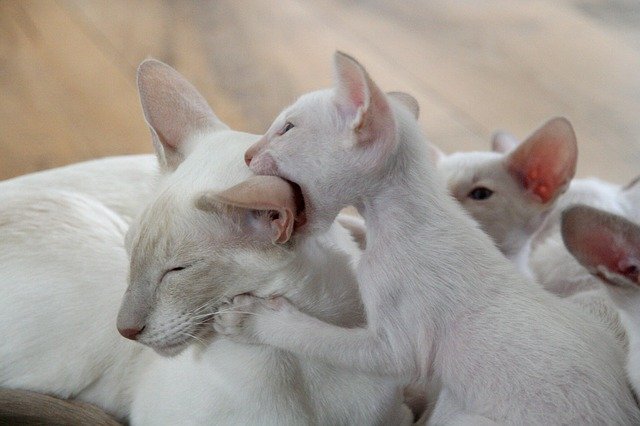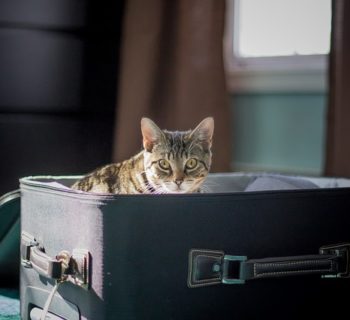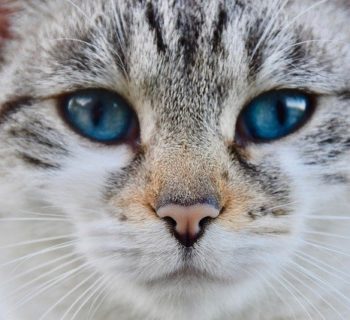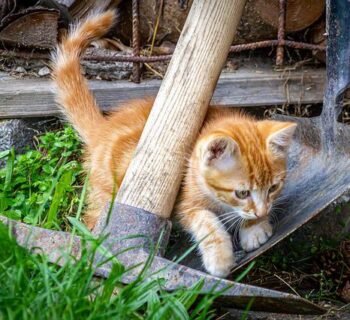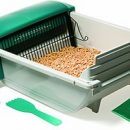https://thepethandbook.com/what-milk-give-kitten/While we love and adore our felines, we'll all agree that cleaning up after they vomit isn't the most pleasant task. Hence, the reason for so many "not again" sighs by cat owners everywhere when they hear the gagging sound.
So, why do cats throw up? If you're a new feline parent, this behavior might surprise the first time it happens, and it's only natural to question why. In this article, we'll discuss some common causes of cat vomiting; we'll also discuss some things you can do to prevent this behavior and also steps to take if your cat's vomiting becomes concerning.
Table of Contents
Why Cats Vomit
There are several reasons for your cat’s vomiting, and we will discuss the known causes below.
Eating Too Quickly
When hungry, our felines can sometimes eat faster than they’re used to. This causes the stomach to try to match its eating pace by expanding too quickly. When this happens, it signals the brain to trigger regurgitation.
This differs from “real” vomit as it involves little or no gagging; your cat simply opens his esophagus to let out the food and fluid.
There are several reasons a cat may eat too quickly, but the two common reasons are gluttony and stress resulting from a food bowl competition (the latter may happen in homes with multiple cats).
Hairballs
Hairballs can cause our cats to vomit. Cats are very sanitary animals, and this means they are often susceptible to over-grooming.
The result of this habit is hairball formation. While quite normal, Vomiting from hairballs may sometimes require close monitoring, especially when it is often painful and excruciating for your cat to pass. When left unchecked in this case, these hairballs can cause painful intestinal blockage resulting in lethargy, anorexia, and constipation.
If your cat hasn’t vomited or passed a hairball longer than usual, you should have him checked. Also, have a vet or a professional feline handler look at him if you notice symptoms such as constipation, lethargy, and anorexia.
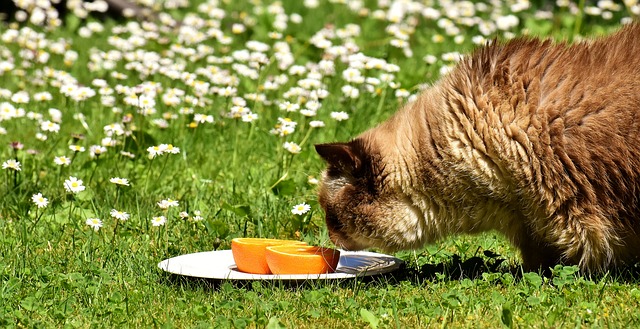
Curiosity-Fueled Behavior
Our cats being curious animals, have no problem ingesting things like grass, toilet paper, and even the carpet if it helps them satiate their curiosity. They, however, vomit it later, and this vomiting action has been discovered to be a protective mechanism. It is one of the several ways cats cleanse their systems from potentially harmful objects.
While you cannot completely keep your cat from the objects mentioned above, you still have to monitor them closely during their “explorative” activities. For one, they could ingest potentially harmful things like strings, toy parts, and feathers, and these could cause severe problems when they lodge in their stomach or even throats.
Try as much as possible to remove these objects from the reach of your cat and if you notice any of these symptoms, quickly have a vet or a pet expert examine him and provide treatment accordingly.
Allergies and Poisons
Our pets are usually prone to food allergies, and this comes as no surprise. Despite thousands of years of domestication, we still have a lot to learn and unravel about our furry friends’ eating habits.
Also, because some cats may be allergic to certain foods, you may, on close observation, discover that your cat is allergic to even some of the common ingredients in their meals, including eggs, wheat, fish, beef, and milk. Also, your cat can develop an overnight allergy to these food ingredients. Therefore, you should not rule out the possibility of a food allergy when diagnosing why your cat is constantly sick.
Pay close attention to your feline’s behavior before and after meals. Check for diarrhea, itchy skin, and bald patches, and if you notice any, speak to a vet or a pet expert. While a simple food change may solve the problem, some cats may require medications and more tests to resolve the issue from within and also curb the vomiting.
Your cat may also vomit when he consumes something poisonous. As a way to expel the foreign body, the cat’s protective mechanism kicks in the form of vomiting. These poisons can include certain indoor and outdoor plants, certain human foods, toxic chemicals, pesticides, and medicines.
Diseases, Infections, and Parasites
Like their humans, our feline friends' vomiting can be a symptom of diseases and infections. Possible conditions include kidney problems, hypothyroidism, liver failure, diabetes, hyperthyroidism, cancer, and irritable bowel disease.
Infections from bacteria or viruses, including giardia and salmonella, are some of the possible reasons your cat may be throwing up.
Parasites are also other common culprits of feline vomiting. Parasites such as roundworms, tapeworms, and whipworms can trigger severe vomiting in their feline host after a while.
When Vomiting Becomes Cause for Concern
While your cat’s vomiting may be due to several less severe reasons, you should watch out for possible signs of a painful underlying condition.
For example, foamy and yellow vomit can usually be a sign of a hairball; thick yellow bile, on the other hand, can indicate the presence of a severe underlying condition, e.g., kidney problem.
If you notice such symptoms, treat them seriously and seek urgent medical care for your cat, especially if accompanied by other symptoms, including appetite loss/sudden appetite increase, lethargy, and generally abnormal behavior.
You should never ignore vomiting, persistent ones that are accompanied by some of the symptoms above. This is because it can lead to dehydration almost immediately and result in more severe complications and even death.
Preventing Your Cat From Vomiting: What You Can Do
Once you’ve ruled out all the possible severe reasons for your cat being sick, the next thing you want to do is try to curb this behavior. While many cats throw up for many non-severe reasons, you should not allow this behavior, at least not when there is a lot you can do about it.
Teach and Help Your Cat to Eat More Slowly
If you have a fast eater, you can prevent the vomiting behavior by getting him to slow down when eating. Instead of full servings, serve him smaller portions. Not only that, place an object, e.g. a small ball inside the food dish, and your cat will naturally be forced to eat around the ball. However, you want to make sure that the ball isn't small enough for him to chew on or worse; swallow.
If you own multiple cats, you would need to feed them at different times and places to prevent competitive eating. If they eat fast even when fed separately, apply the portion control and ball method.
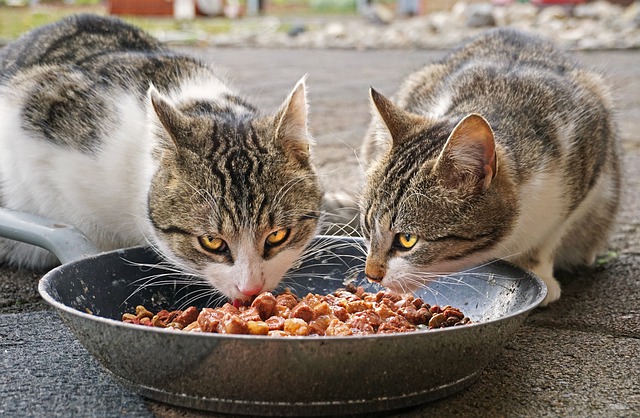
Adjust the Cat’s Diet
Another step you can take to manage this behavior is adjusting your cat’s diet. There are foods with limited ingredients formulated to accommodate cats with stomach issues (if your cat’s vomiting is triggered by a stomach problem or sensitivity to food ingredients). Cats adjust well to newly introduced, high-quality meals. However, you still want to be on the safe side when introducing a new meal. Below are some tips to help you ensure that your cat’s food transition is as problem-free as possible.
Start Slowly
You want to make the switch to a new food gradually to help your cat adjust with zero or as minimal adverse reaction as possible.
Introduced suddenly, and at the same quantity with the old meal, your cat may develop stomach problems. You also don’t want to stop a supposedly allergy-causing meal abruptly without a replacement.
Make It Appealing
The switch from one food to another should not only be gradual, but also appealing. If your cat was previously fed wet food and is now being transitioned to dry food, you may need to add some water and heat it up a bit for more appeal. Also, every partly eaten food should not be kept open for over 20 minutes to prevent contamination.
Portion Control
While you want your cat to be well-fed, you also want to make sure he is not being overfed. So, how much should you feed your cat? Your cat’s age, breed, sex, activity level, and overall health will decide this.
Discuss with your veterinarian and also read the product’s instructions to feed correctly. Understand that all foods are not of the same quality; some are more nutrient-dense and filling than the others and so may require serving in smaller quantities or frequencies.
Closely Monitor
Apart from serving the correct measurements of the food, you should monitor your cat by regularly checking its weight. This is especially important when you switch to a premium food brand. As stated above, these are usually more nutrient-dense, and even though your cat may appear contented and happy after meals, they can soon become overweight.
Final Thoughts
Again, vomiting isn't something uncommon with felines. However, if you wonder why does your cat throw up frequently (three or more times in a month), you should seek a professional’s help for treatment and also make changes to his overall lifestyle.
The pet professional may prescribe treatments in the form of medications and meal changes. You also have to do your part by removing potentially harmful objects from his reach. When these steps are carried out, you should notice a significant decrease in your cat's stomach and vomiting problems.
Thoughts? Questions? Share in the comment section below.
About the Author
Kirsten Heggarty
Kirsten created The Pet Handbook with the aim of sharing her knowledge about pets, pet food, healthy habits, and more. All of her advice is based on years of her own experience with her pets, and feedback that she has received from grateful readers about her tips. If you want to know more please read the About Me page.

